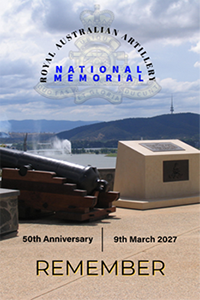The book by Nicolas Floyd and Paul Stevens entitled Action! Action! Action! A Short History of the Employment of Australian Artillery 1871 - 2021 delivers on what its title declares. This is an action packed and expansive survey of the way Australian Army Artillery has been organised and employed for over 150 years. It draws on the excellent scholarship that precedes it, notably, David Horner's highly regarded work, The Gunners. But it goes further, drawing on extensive fresh archival research and informed by other recent scholarship and the expertise of the two authors in the field. The end result is a book that makes the technical functions and workings of artillery accessible and interesting, even to the novice reader, taking them through some of the intricacies of artillery in plain English.
Spanning colonial times through to the early years following federation and through the world wars, the Cold War, the post-Cold War years and on to the present, the book explains the nature and significance of garrison and field force artillery and, later, anti-aircraft and air defence artillery. Using accessible language, it walks the reader through the technology and tactics employed, showing how Australian Artillery evolved over time and how it adapted to shifting demands. Complicated technological innovations are made readily understandable - including such things as direct and indirect fire, fuses, howitzers, as well as towed, pack and motorised forms of light, medium and heavy artillery, along with locating radars, missiles, etc. The book explains how these things work, why they have proved useful, how they affected developments on the battlefield and how, in turn, they were affected by the evolving tactics and emerging technology over the intervening one and a half centuries. Importantly, the book also places these technical and operational developments in the context of the broader history of the Australian Army. It includes a considerable range of excellent colour photographs and accessible maps covering the people, places and events that help bring the story to life. It also features extensive appendices showing how the organisation evolved over time, tracking the peaks and troughs of wartime and peacetime.
As recent events in Ukraine have shown, artillery remains a critical capability on the modern battlefield, and also one that continues to evolve, as technological and tactical innovations demand further adaptation. The book shows how while in the early post-Cold War years Australian Artillery was in some respects relegated to being a second tier part of the force, recent developments have brought artillery back to centre stage – with longer range projectiles and the availability of technology allowing for greater precision guidance driving a reinvigoration of Australian Artillery capabilities for the present and potential future needs.
This book will be of interest to military practitioners, including not just those with a direct interest as members of Australian Artillery, but also for those in other parts of the profession of arms eager to understand how artillery fits into the broader scheme of defence capabilities. It is also accessible for the lay reader, for the enthusiast and amateur historian, and beyond.
Professor John Blaxland, Colonel (Ret’d), BA (Hons), MA, PhD, psc (RT), SFHEA, FRSN, MSM (USA)
Director ANU North America Liaison Office, Washington DC
Professor of International Security & Intelligence Studies, Strategic and Defence Studies Centre, Coral Bell School of Asia Pacific Affairs, Australian National University |




